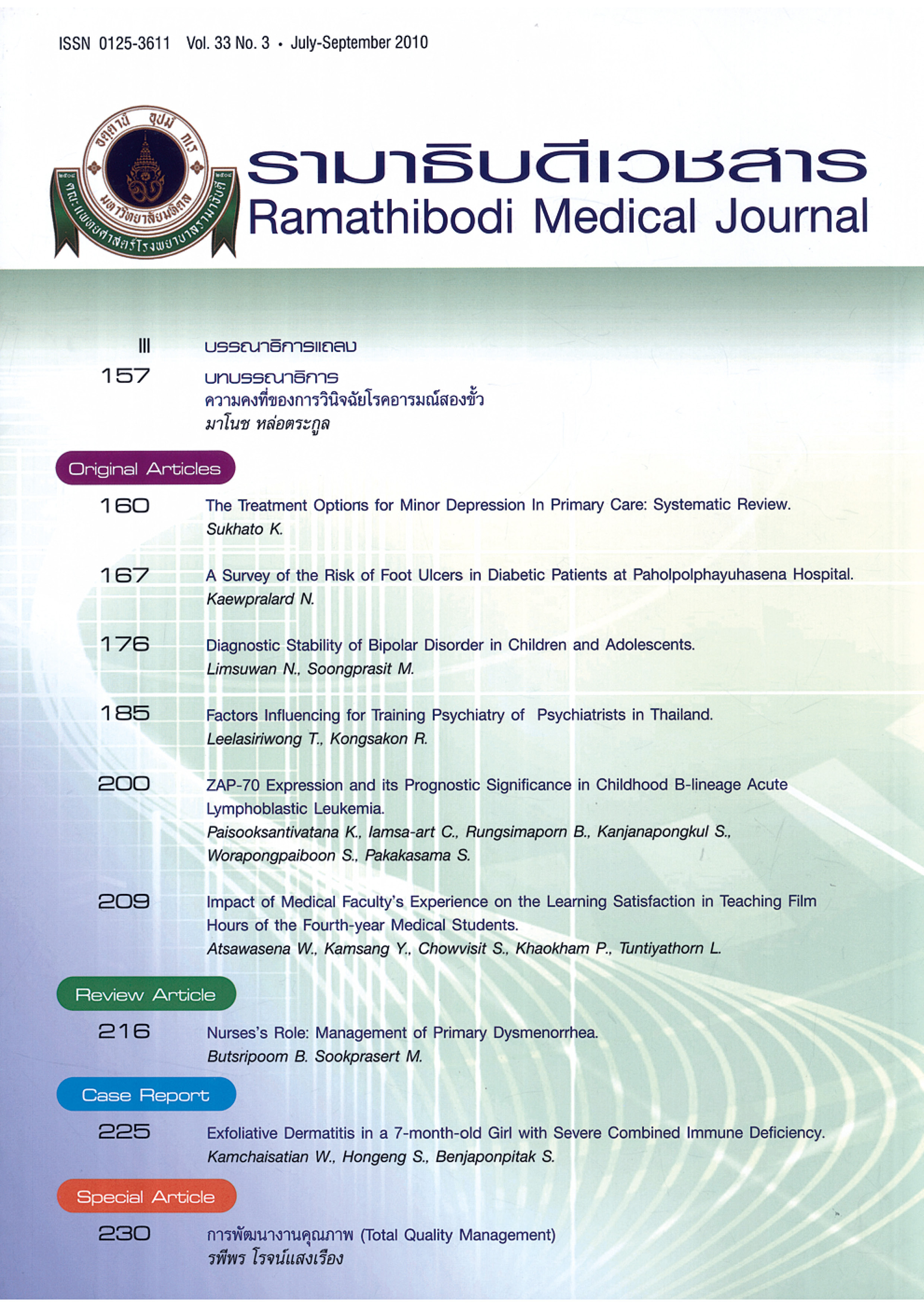Exfoliative Dermatitis in a 7-month-old Girl with Severe Combined Immune Deficiency
Keywords:
Severe combined immunodeficiency, Immune deficiency, SCID, Primary immune deficiencyAbstract
Background: Severe combined immunodeficiency (SCID) is a rare, fatal syndrome with profound deficiencies of T and B cells function. Clinically, the patients have serious infection caused by bacterial, viral or opportunistic organisms. Exfoliative dermatitis is an uncommon manifestation induced by graft-versus-host disease (GVHD) from maternal lymphocytes.
Objective: We report a case of SCID who presented with exfoliative dermatitis without evidence of GVHD.
Case Report: A 7-month-old girl presented with exfoliative dermatitis since one month of age. She had oral candidiasis. pneumonia, chronic diarrhea and failure to thrive. She was found to have markedly low level of immunoglobulin G, A and M. T and B cells enumeration revealed CD4 cells, 13%, CD8 cells 1%, CD19 cells, 83% and CD16/56 cells, 3.8%. The lymphocyte proliferation to mitogen (phorbol myristate acetate) assay was poorly-responded. DNA typing analysis from her skin biopsy could not demonstratce the maternal DNA. She died from serious infection after starting bone marrow transplantation. The autopsy revealed severe depletion of both lymphoid and thymus gland with multinucleated giant cells and intracytoplasmic inclusion bodied in lung pathology.
Conclusion: We have demonstrated a case of SCID presented with dermatosis, which did not induce by GVHD. The patient needed early recognition to prevent uncontrolled infection, leading to death unless immunological reconstruction was done.
References
Stephan JL, Vlekova V, Le Deist F, et al. Severe combined immunodeficiency: a retrospective single-center study of clinical presentation and outcome in 117 patients. J Pediatr. 1993;123(4):564-572. doi:10.1016/s0022-3476(05)80951-5.
Buckley RH, Schiff RI, Schiff SE, et al. Human severe combined immunodeficiency: genetic, phenotypic, and functional diversity in one hundred eight infants. J Pediatr. 1997;130(3):378-387. doi:10.1016/s0022-3476(97)70199-9.
Denianke KS, Frieden IJ, Cowan MJ, Williams ML, McCalmont TH. Cutaneous manifestations of maternal engraftment in patients with severe combined immunodeficiency: a clinicopathologic study. Bone Marrow Transplant. 2001;28(3):227-233. doi:10.1038/sj.bmt.1703128.
Gatti RA, Nakamura Y, Nussmeier M, Susi E, Shan W, Grody WW. Informativeness of VNTR genetic markers for detecting chimerism after bone marrow transplantation. Dis Markers. 1989;7(2):105-112.
Katz F, Malcolm S, Strobel S, Finn A, Morgan G, Levinsky R. The use of locus-specific minisatellite probes to check engraftment following allogeneic bone marrow transplantation for severe combined immunodeficiency disease. Bone Marrow Transplant. 1990;5(3):199-204.
Hoeger PH, Harper JI. Neonatal erythroderma: differential diagnosis and management of the "red baby". Arch Dis Child. 1998;79(2):186-191. doi:10.1136/adc.79.2.186.
Friedrich W, Müller SM. Allogeneic stem cell transplantation for treatment of immunodeficiency. Springer Semin Immunopathol. 2004;26(1-2):109-118. doi:10.1007/s00281-004-0158-2.
Notarangelo LD. Primary immunodeficiencies. J Allergy Clin Immunol. 2010;125(2 Suppl 2):S182-S194. doi:10.1016/j.jaci.2009.07.053.













